Abell 39 is a planetary nebula located approximately 3,800 light-years away in the northern constellation Hercules. It has an integrated apparent visual magnitude of 13.7 and an angular size of 155.1 by 154.5 seconds of arc. It appears in the region of the Keystone asterism, near the star Zeta Herculis.
Like all planetary nebulae, Abell 39 formed when an evolved red giant star reached the end of its evolutionary cycle and expelled its outer layers into space. As the gaseous shell expands away from the central stellar remnant, it is ionized by the intense ultraviolet light of the exposed stellar core and appears as a brightly coloured nebula. Abell 39 has an expansion velocity between 32 and 37 km/s. It has been expanding for around 11,000 years.
Abell 39 is an unusual example of a planetary nebula. It appears almost perfectly spherical and has an almost uniform spherical shell. The nebula’s bright rim is around 10.1 arcseconds (0.19 light years) thick. The main shell is surrounded by a faint, high excitation halo that stretches about 18 arcseconds from the rim, giving the nebula a complete diameter of 190 arcseconds. The nebula’s blue light comes from ionized oxygen (OIII).
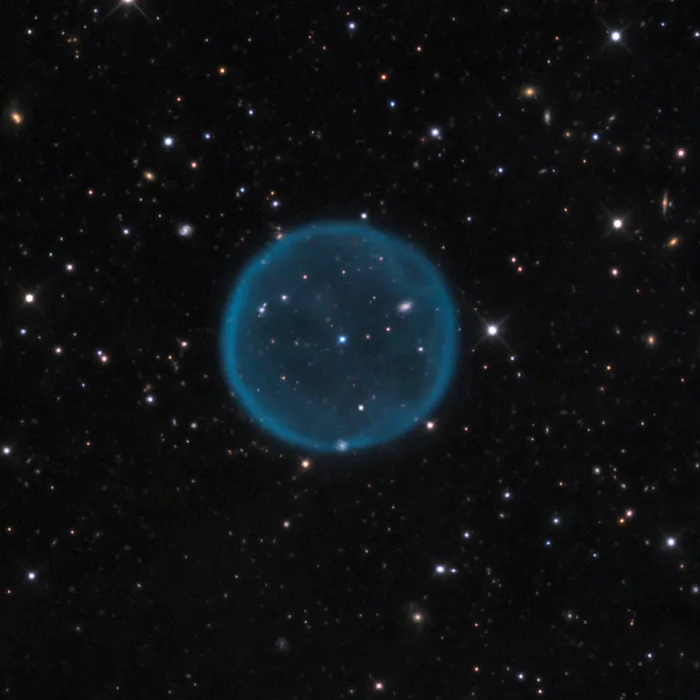
Planetary nebula Abell 39 captured from the Mount Lemmon SkyCenter using the Schulman 32 inch Telescope. Image credit: Adam Block/Mount Lemmon SkyCenter/University of Arizona (CC BY-SA 3.0)
Abell 39 lies 2,600 light-years above the galactic plane. Its central star has an estimated mass of 0.61 solar masses and an apparent magnitude of 15.5. It has an estimated temperature of 8,900 K and is classified as a subdwarf O star. Subdwarf O stars are exceptionally hot stars with about half the Sun’s mass and prominent lines of ionized helium in their spectra. They are believed to have carbon-oxygen cores surrounded by a helium-burning shell.
The nebular material has a similar mass, 0.6 solar masses. The progenitor star appears offset from the nebula’s centre by about 2 arcseconds, corresponding to a physical distance of 0.1 light years. The star’s position west of the bubble’s centre is thought to have been caused by an asymmetric mass ejection in the past, which accelerated the star.
With a radius of 1.4 light-years, Abell 39 is one of the largest known spheres in the night sky. The eastern limb of the nebula is about 50 percent more luminous than the western. The asymmetry is attributed to the offset of the planetary nebula nucleus (PNN).
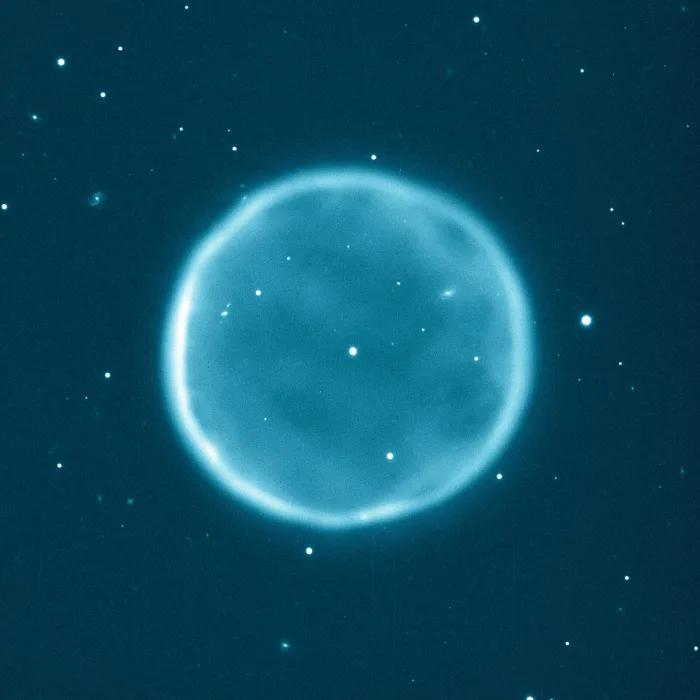
Abell 39, the 39th entry in a catalog of large nebulae discovered by George Abell in 1966, is a beautiful example of a planetary nebula. It was chosen for study by George Jacoby (WIYN Observatory), Gary Ferland (University of Kentucky), and Kirk Korista (Western Michigan University) because of its beautiful and rare spherical symmetry. This picture was taken at the WIYN Observatory’s 3.5-m (138-inch) telescope at Kitt Peak National Observatory, Tucson, AZ, in 1997 through a blue-green filter that isolates the light emitted by oxygen atoms in the nebula at a wavelength of 500.7 nanometers. Image credit: WIYN/NOIRLab/NSF (CC BY 4.0)
Facts
The designation Abell 39 (PN A66 39) comes from American astronomer George Ogden Abell’s Abell Catalog of Planetary Nebulae (1966), in which the nebula was listed as the 39th object. Abell’s catalogue included 86 planetary nebulae discovered either by himself or by Albert George Wilson as part of the National Geographic Survey – Palomar Observatory Sky Survey before August 1955. Abell 39 was discovered by George Abell in 1955. The nebula was previously included in Abell’s catalogue of 1955 as PN A55 27.
Location
Abell 39 appears in the western part of the constellation Hercules, in the region of the Keystone, a relatively bright asterism that outlines the torso of Heracles. The asterism is formed by Pi, Eta, Zeta and Epsilon Herculis.
The nebula appears roughly halfway between Rasalhague in Ophiuchus and Nekkar in Boötes. Rasalhague marks the top of the large polygon that takes up much of Ophiuchus, while Nekkar sits at the top of the Kite of Boötes.
Abell 39 lies along the imaginary line extended from Zeta Herculis in the direction of the Serpent’s head. It can be found around 4.7 degrees southwest of Zeta Herculis. The nebula is a difficult object to observe visually because it has a low surface brightness. It is best seen in large telescopes at high magnification with OIII filters.
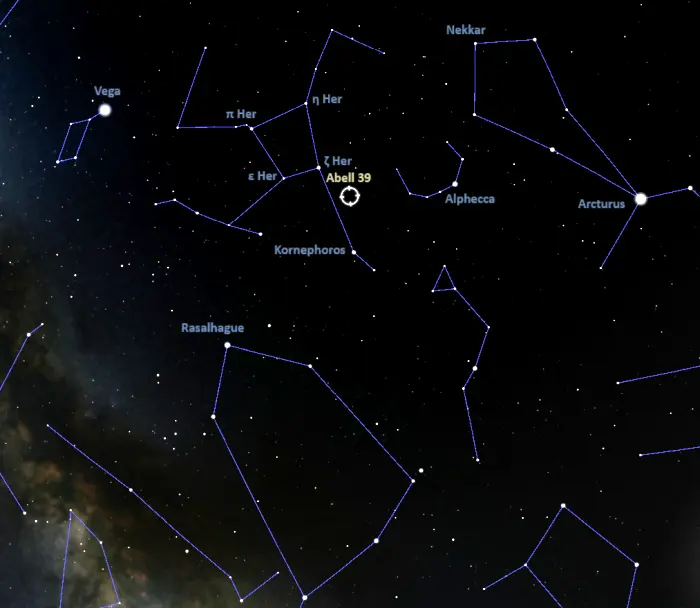
The location of the planetary nebula Abell 39, image: Stellarium
Abell 39
| Constellation | Hercules |
| Object type | Planetary nebula |
| Right ascension | 16h 27m 33.7199223168s |
| Declination | +27° 54′ 33.471380376″ |
| Apparent magnitude | 13.7 |
| Apparent size | 155.1″ × 154.5″ |
| Distance | 3,800 light-years (1,165 parsecs) |
| Radius | 1.4 light-years |
| Names and designations | Abell 39, PN A66 39, PN A55 27, PN ARO 180, PN VV’ 140, PK 047+42 1, PN G047.0+42.4, PG 1625+280, IRAS 16255+2801, IRAS F16255+2801, 2MASS J16273371+2754334, CSI+28-16255, PSCz P16255+2801, TIC 219745583, UBV 13929, UBV M 44668, WD 1625+280, Gaia DR2 1305573511415857536, Gaia DR3 1305573511415857536, GALEX J162733.8+275435, GALEX J162733.8+275432, GALEX J162733.8+275434, GALEX J162733.8+275433, GALEX J162733.7+275433, GEN# +6.20056039, GSC2 N13220123587 |
Images
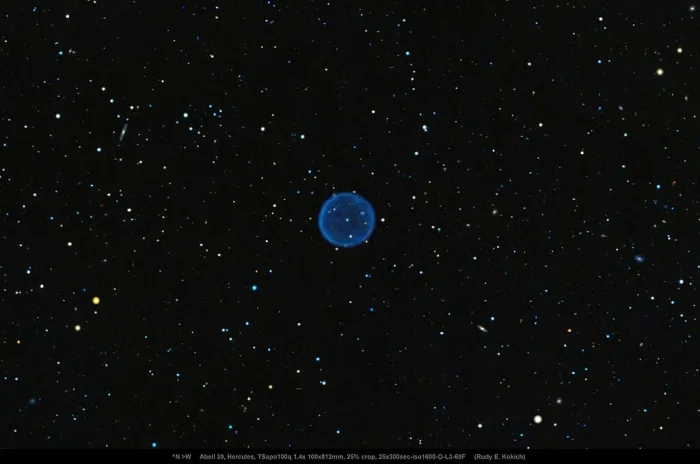
This low surface brightness planetary nebula in Hercules was discovered around 1955 by Abell and Wilson during the National Geographic Society Palomar Observatory Sky Survey. Planetary nebulae are formed when red giant stars run out of nuclear fuel in their cores, gravitationally collapse into white dwarfs, and eject their outer layers into an expanding shell of gas. Illuminated by the central white dwarf, the shell remains visible in blue-green light for tens of thousands of years before diffusing into space. Image credit: Rudy Kokich (PD)
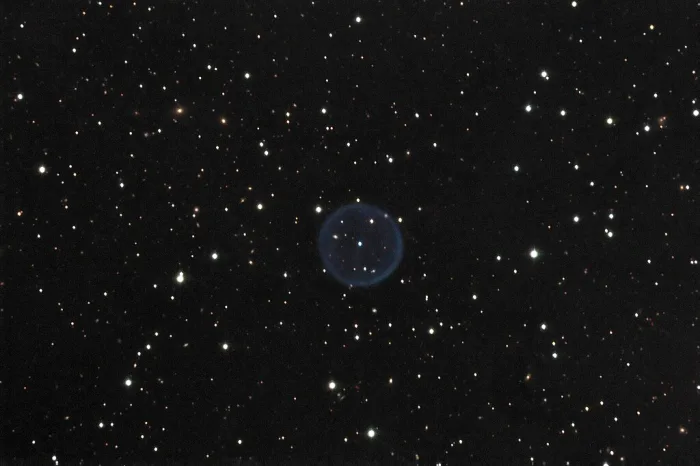
Abell 39 is perhaps one of the most perfect examples of a spherical planetary nebula in the galaxy. As expected, a sphere of gas will show a brighter limb (“edge”) since that line of sight has more gas than the view through the center (two layers) of the bubble. This one is unfortunately very faint and subtle. Details of the bubble require a larger telescope (or very long exposures) to bring out. Note the myriad of background galaxies in the image- especially through the transparent sphere of gas. Also note that the central star is distinctly blue-white in color. A blue-white color indicates that the central star (white dwarf) is very hot. It emits copious amounts of UV radiation which excite the surrounding gas and make it fluoresce its green-blue color. This image was taken as part of Advanced Observing Program (AOP) program at Kitt Peak Visitor Center during 2014. Credit: KPNO/NOIRLab/NSF/AURA/Ken Hotelling and David Whigham/Flynn Haase (CC BY 4.0)
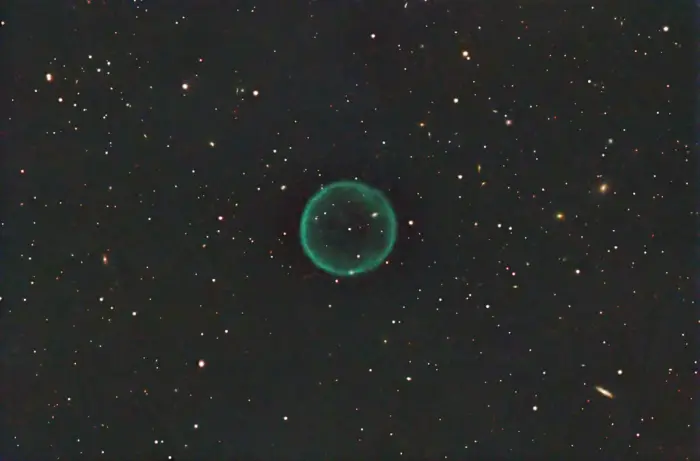
Abell 39, image credit: Juan Lacruz (CC BY 4.0)